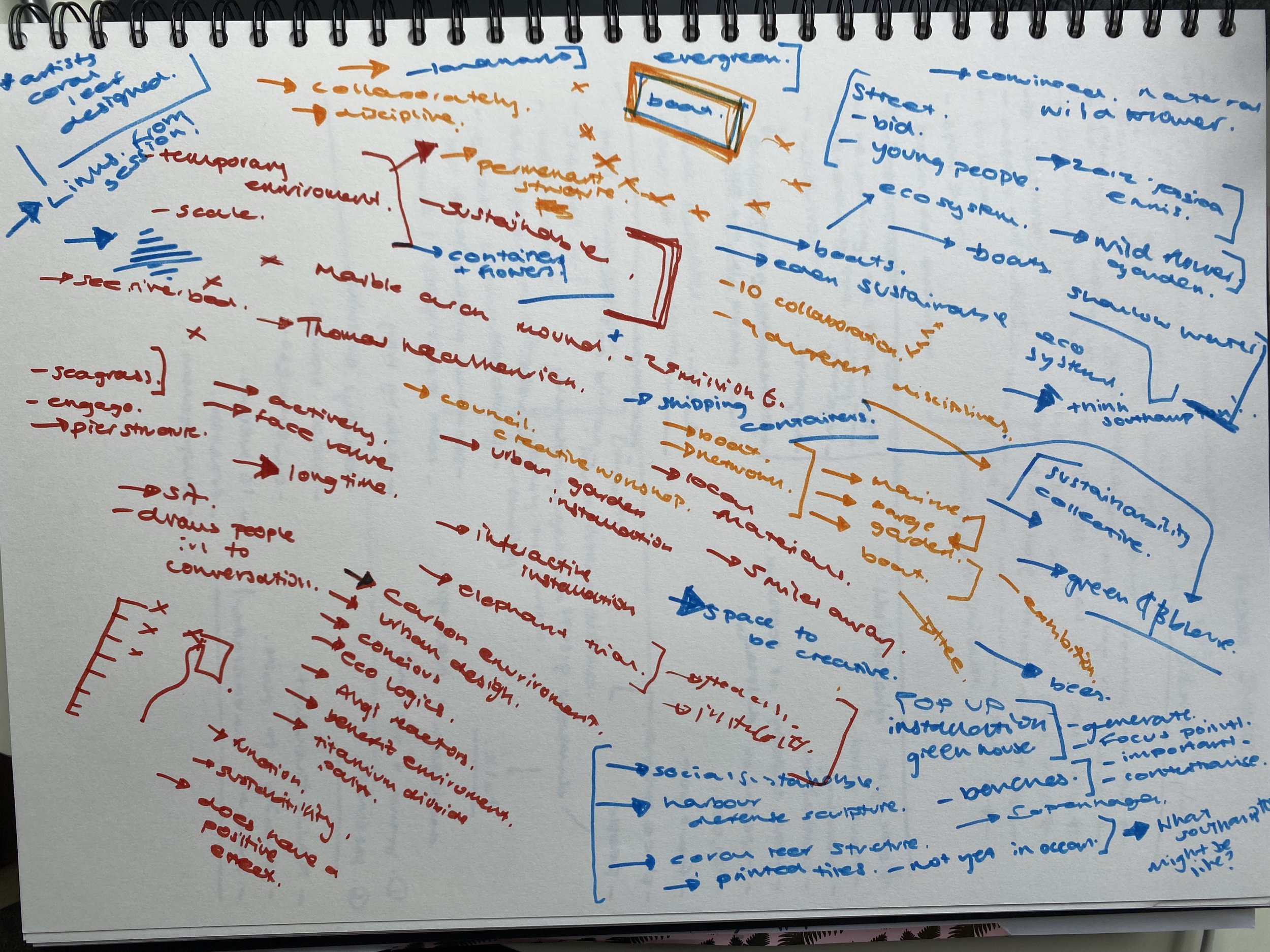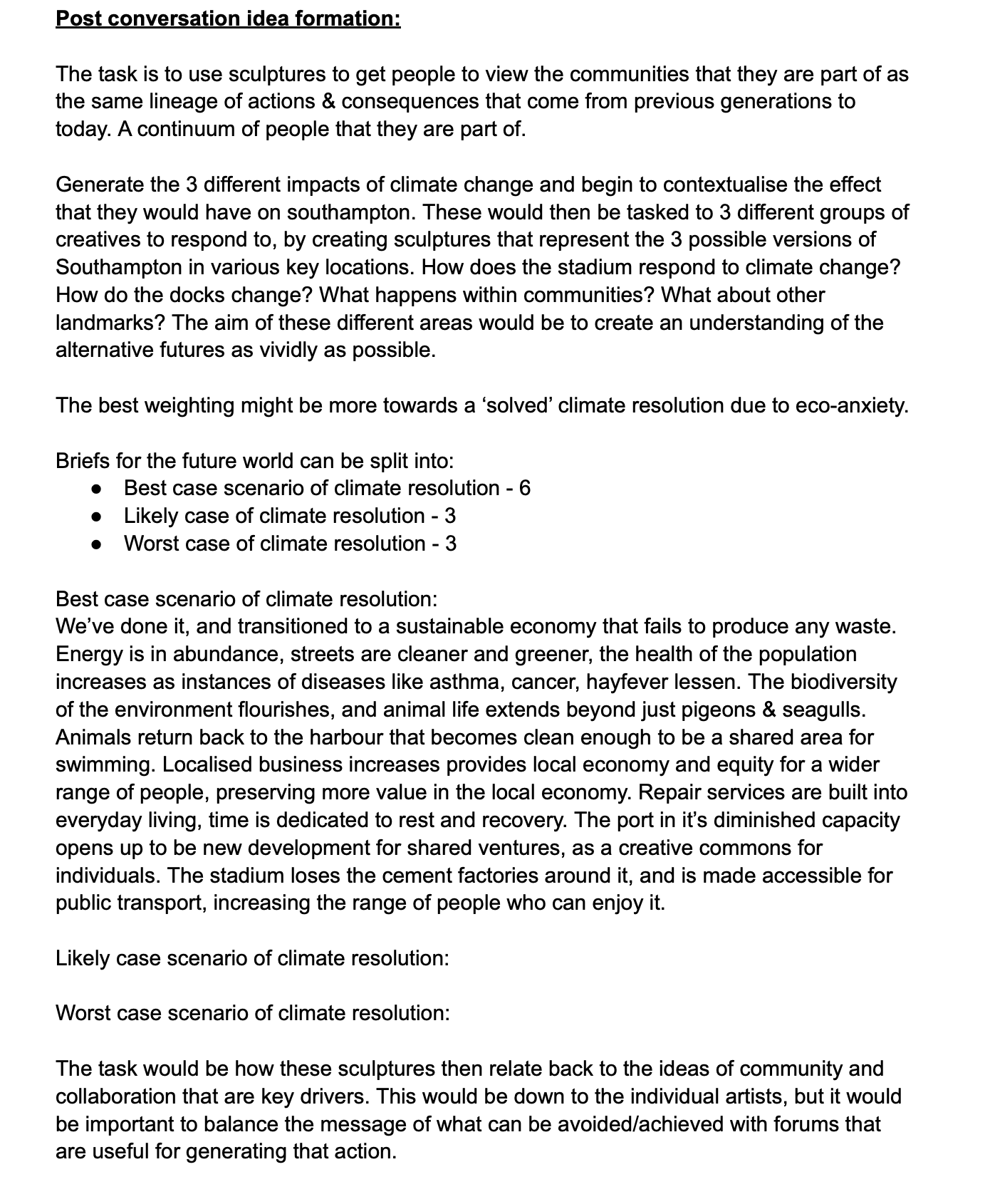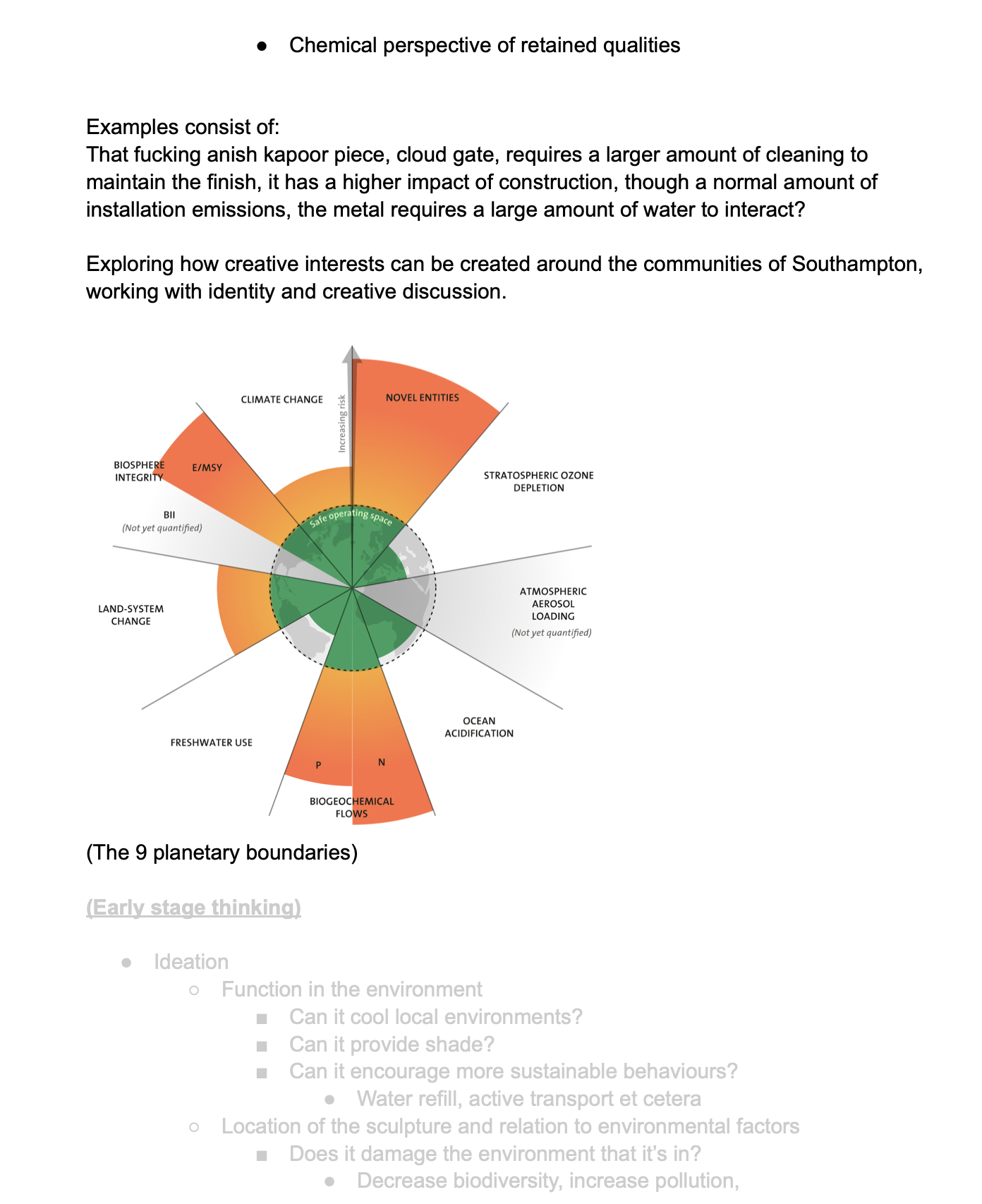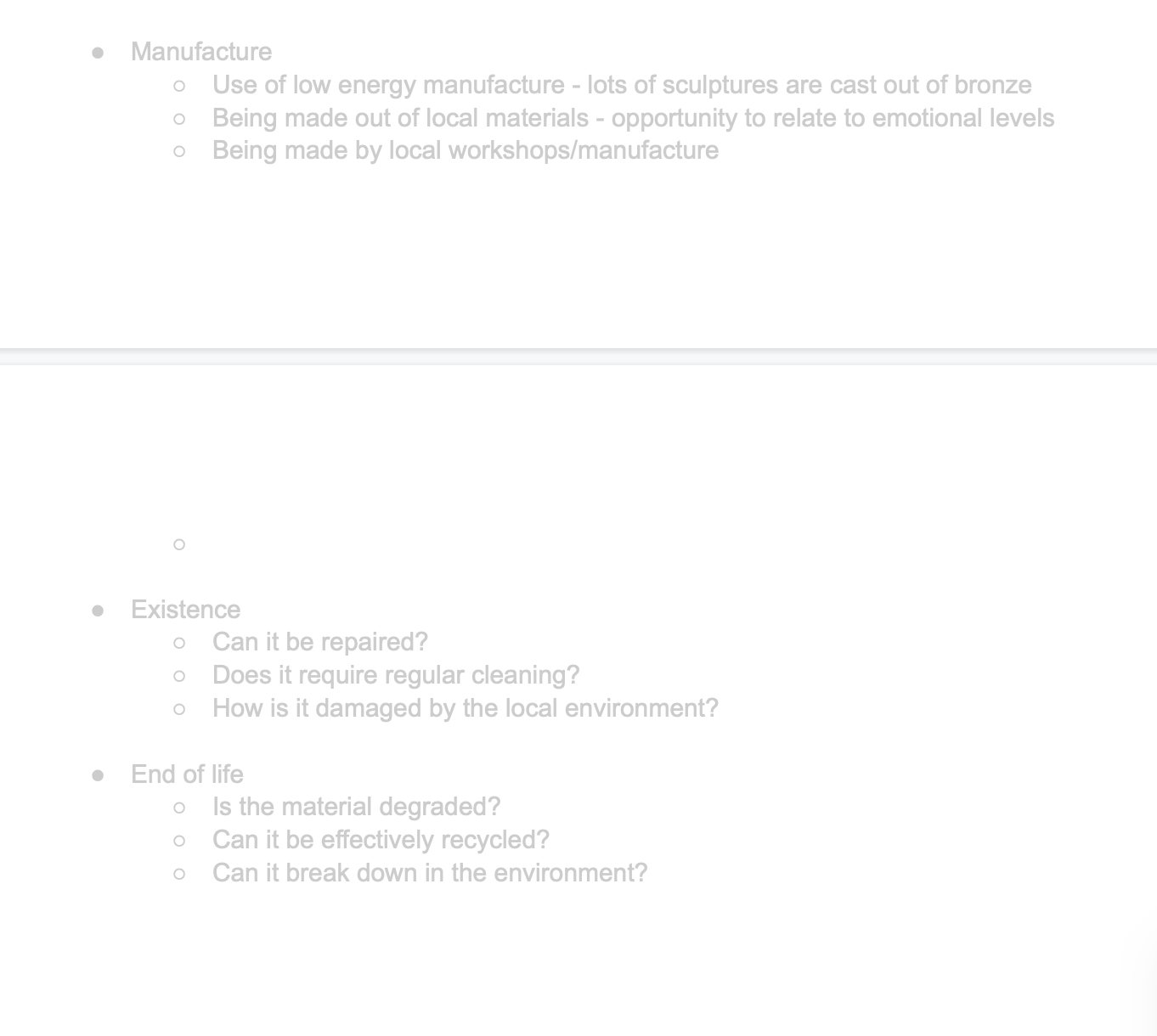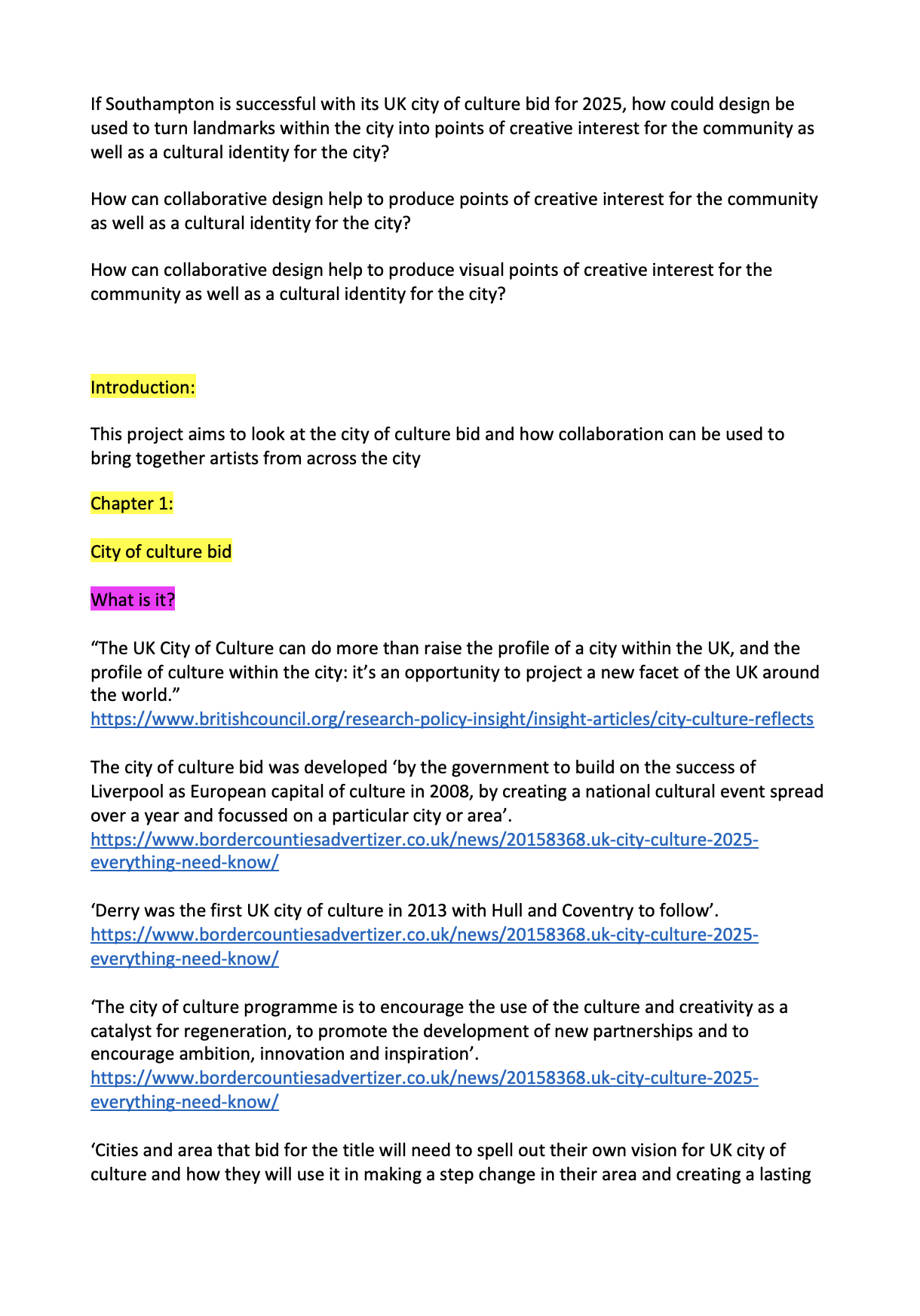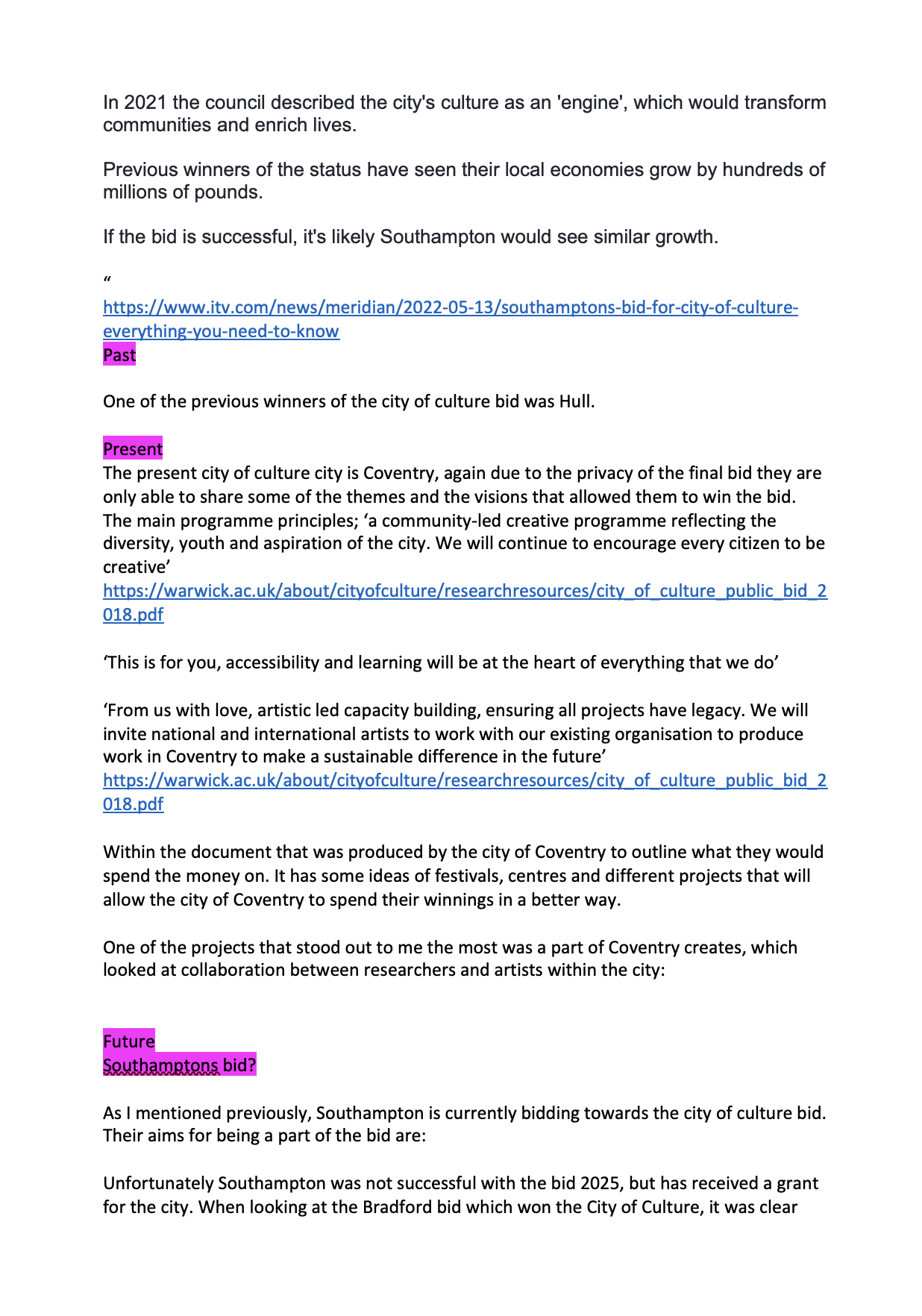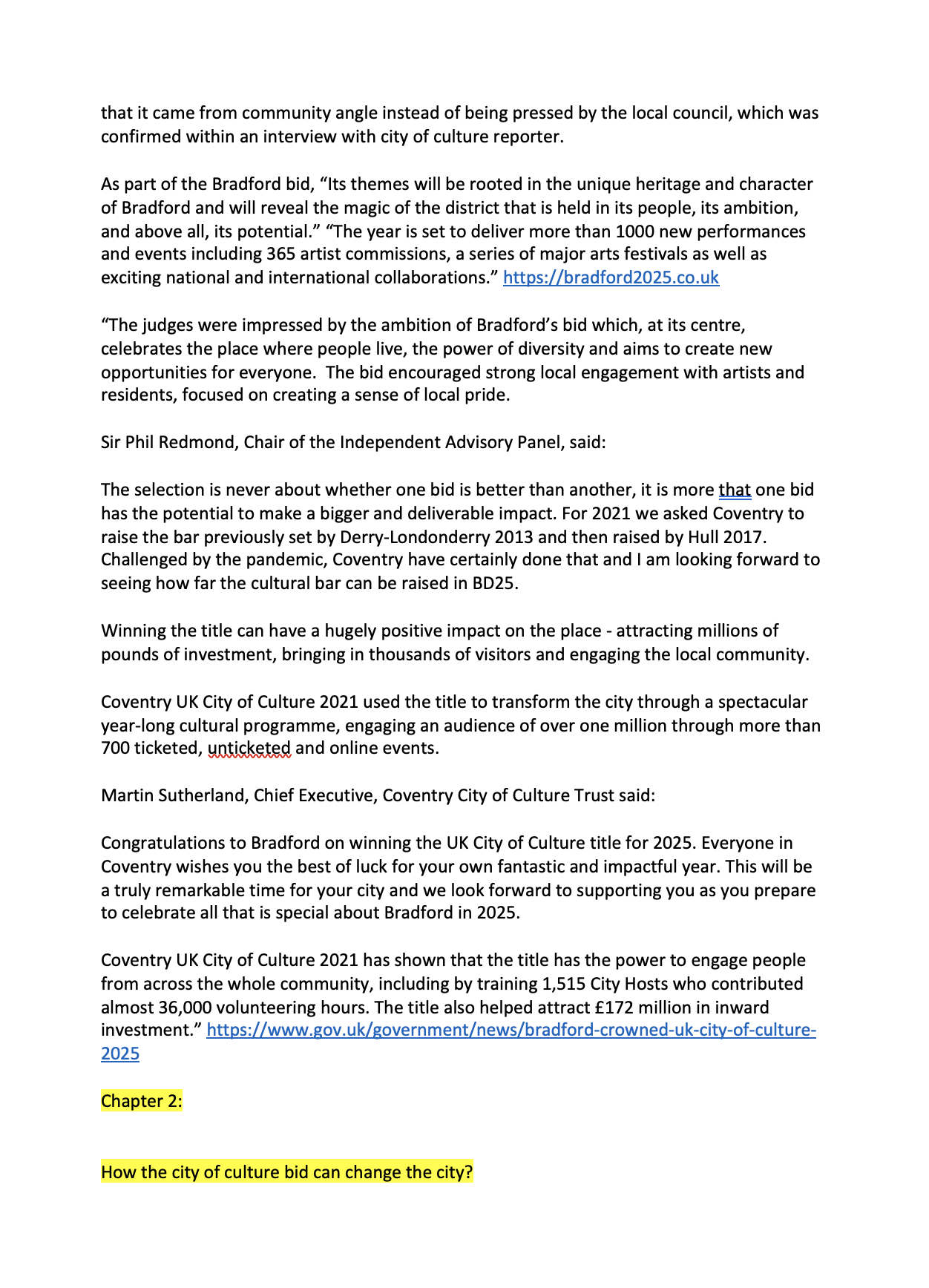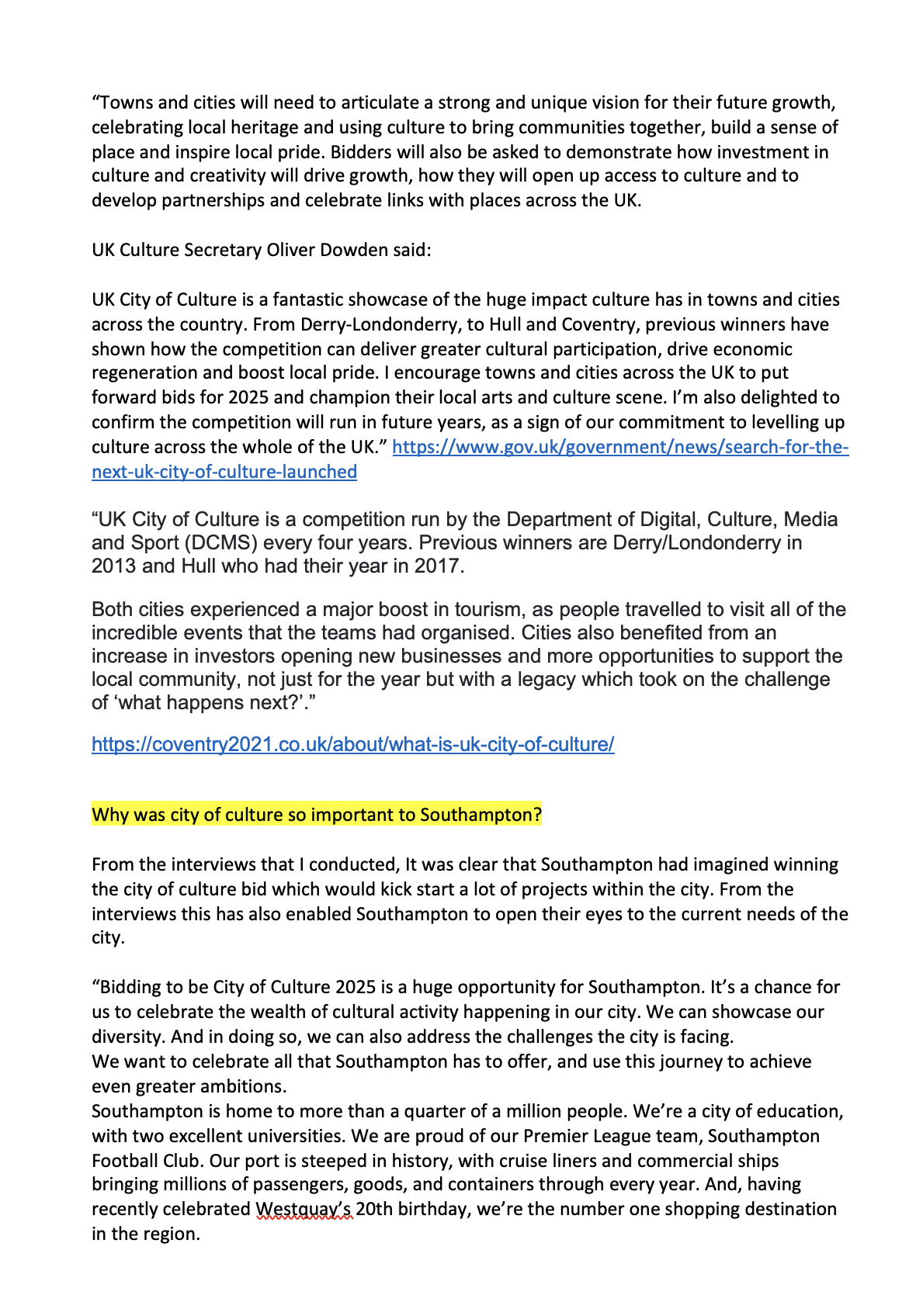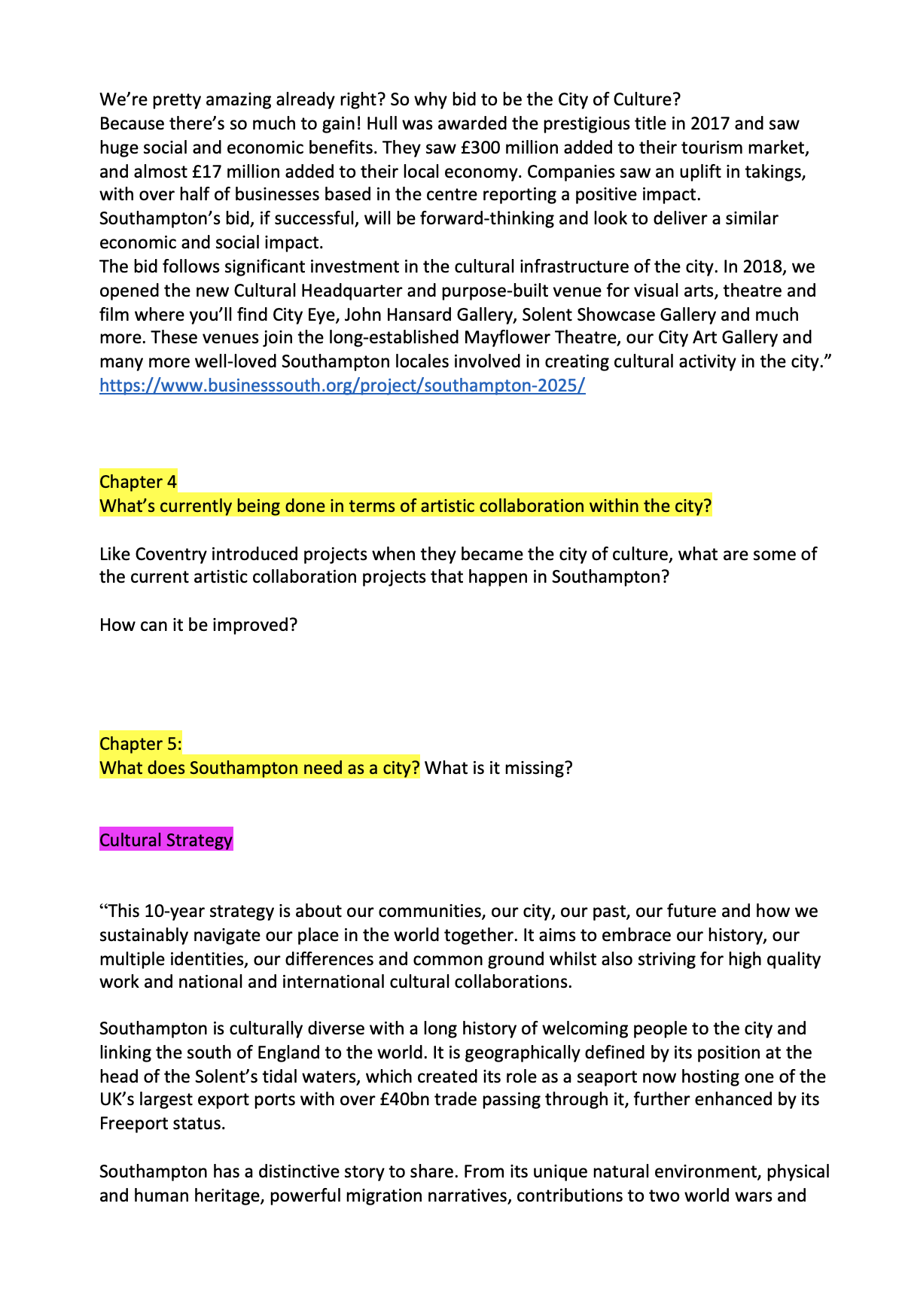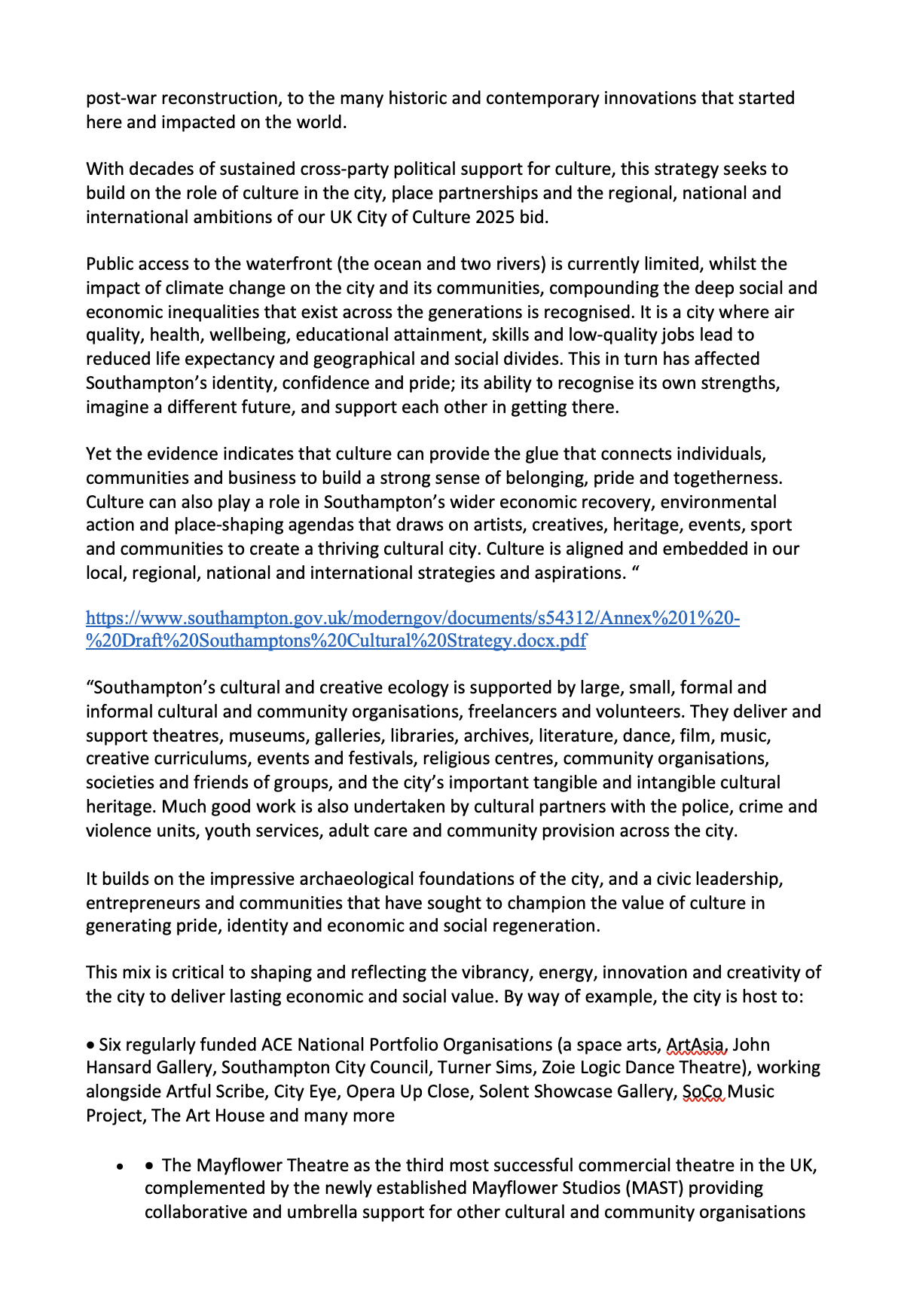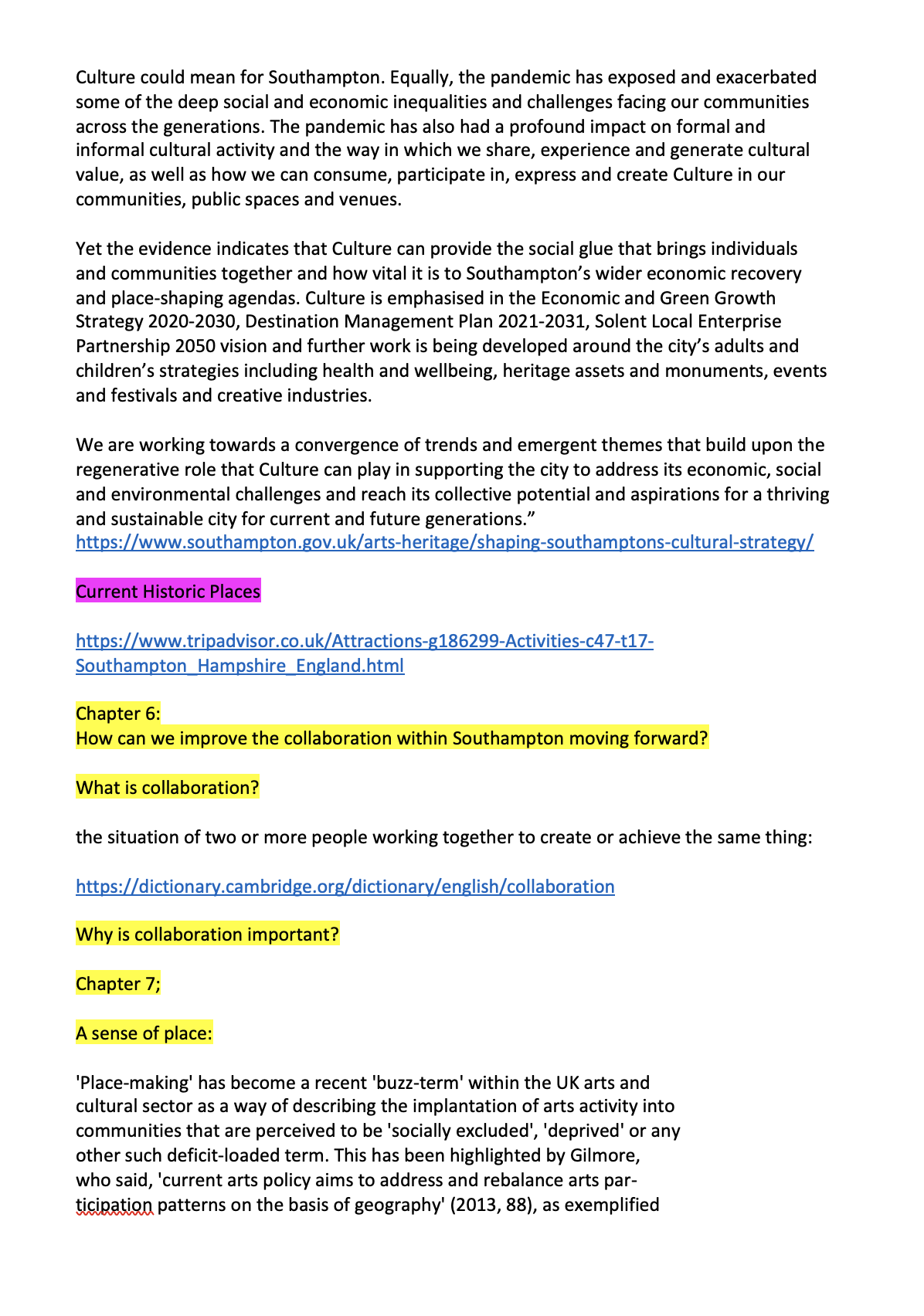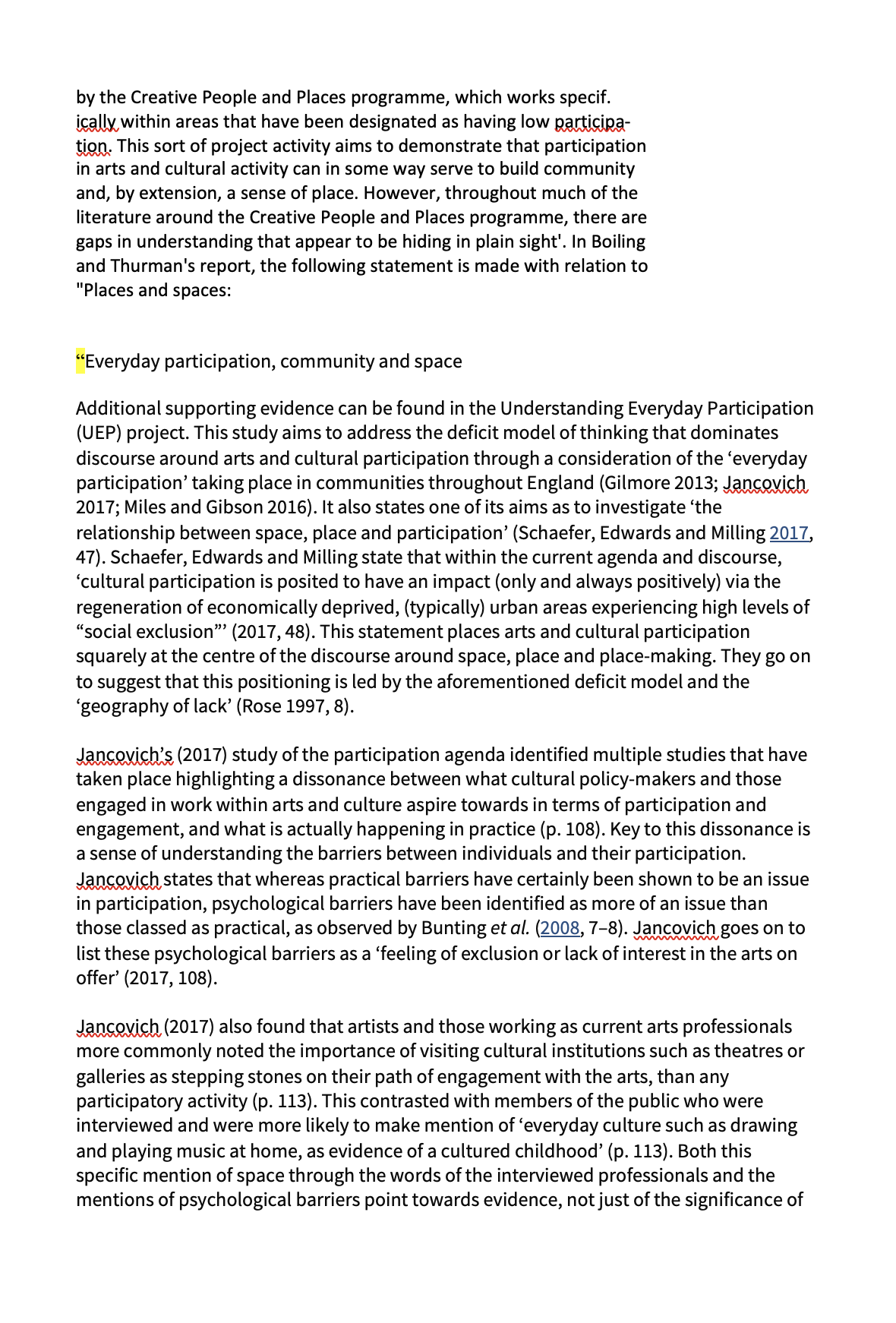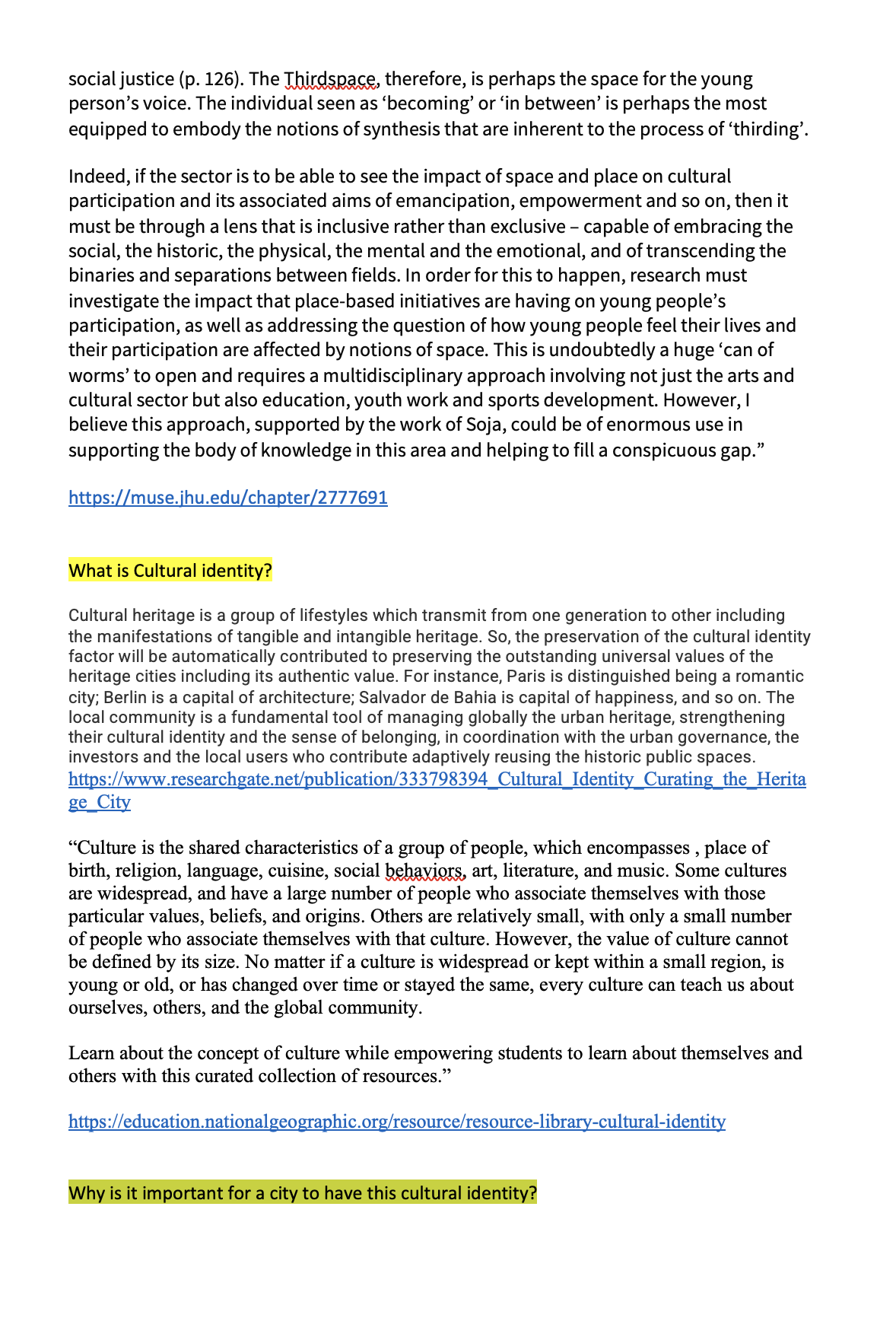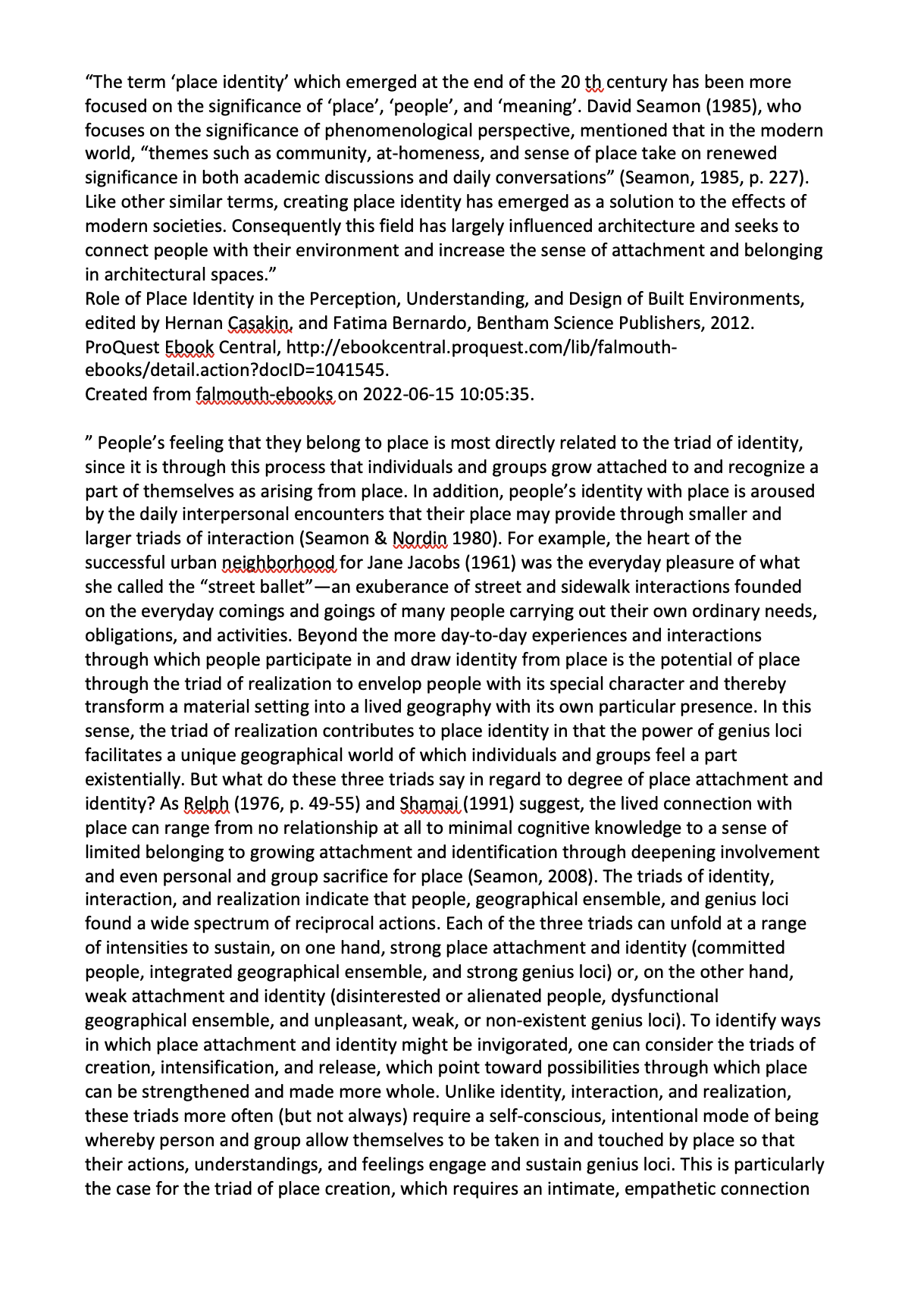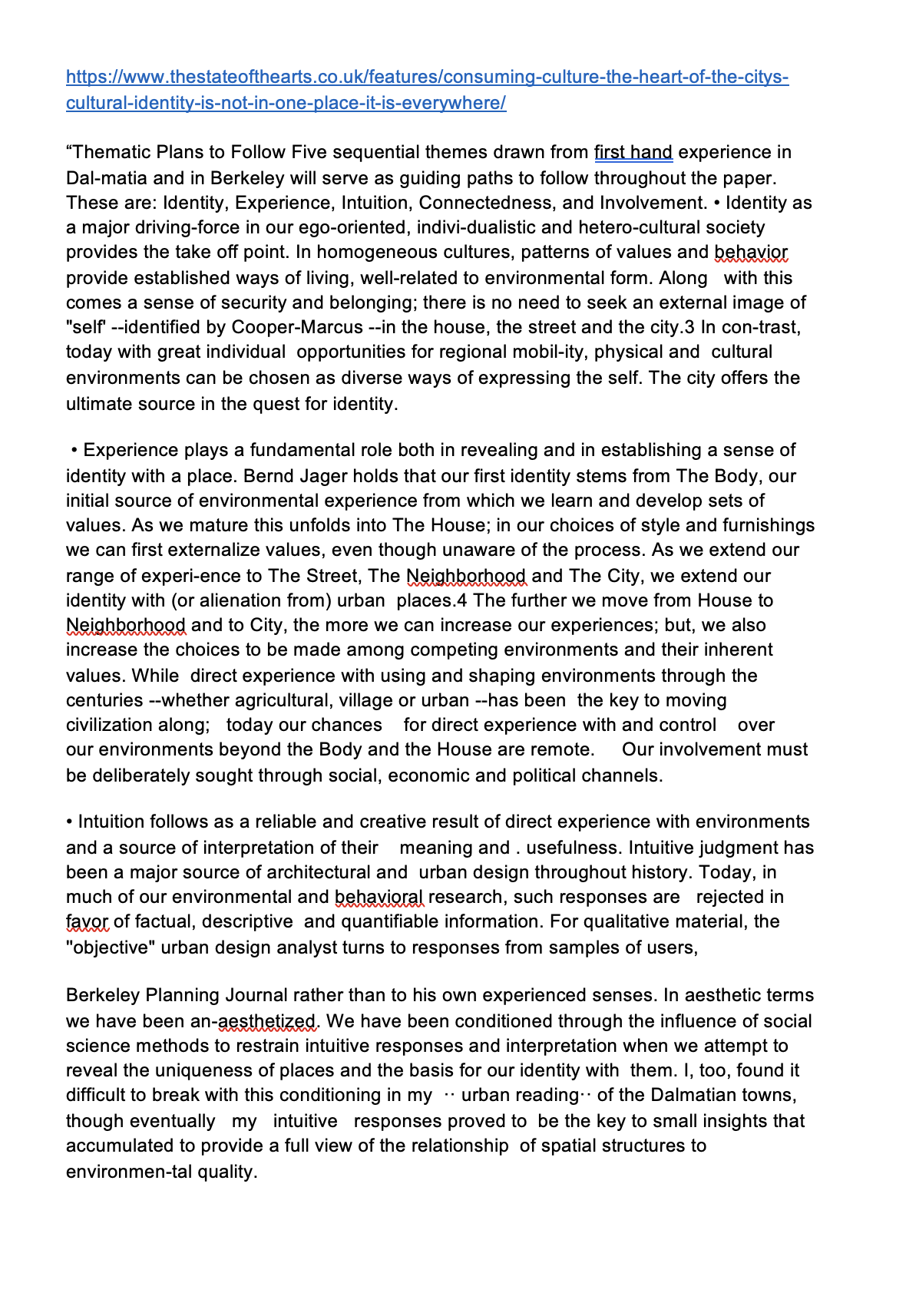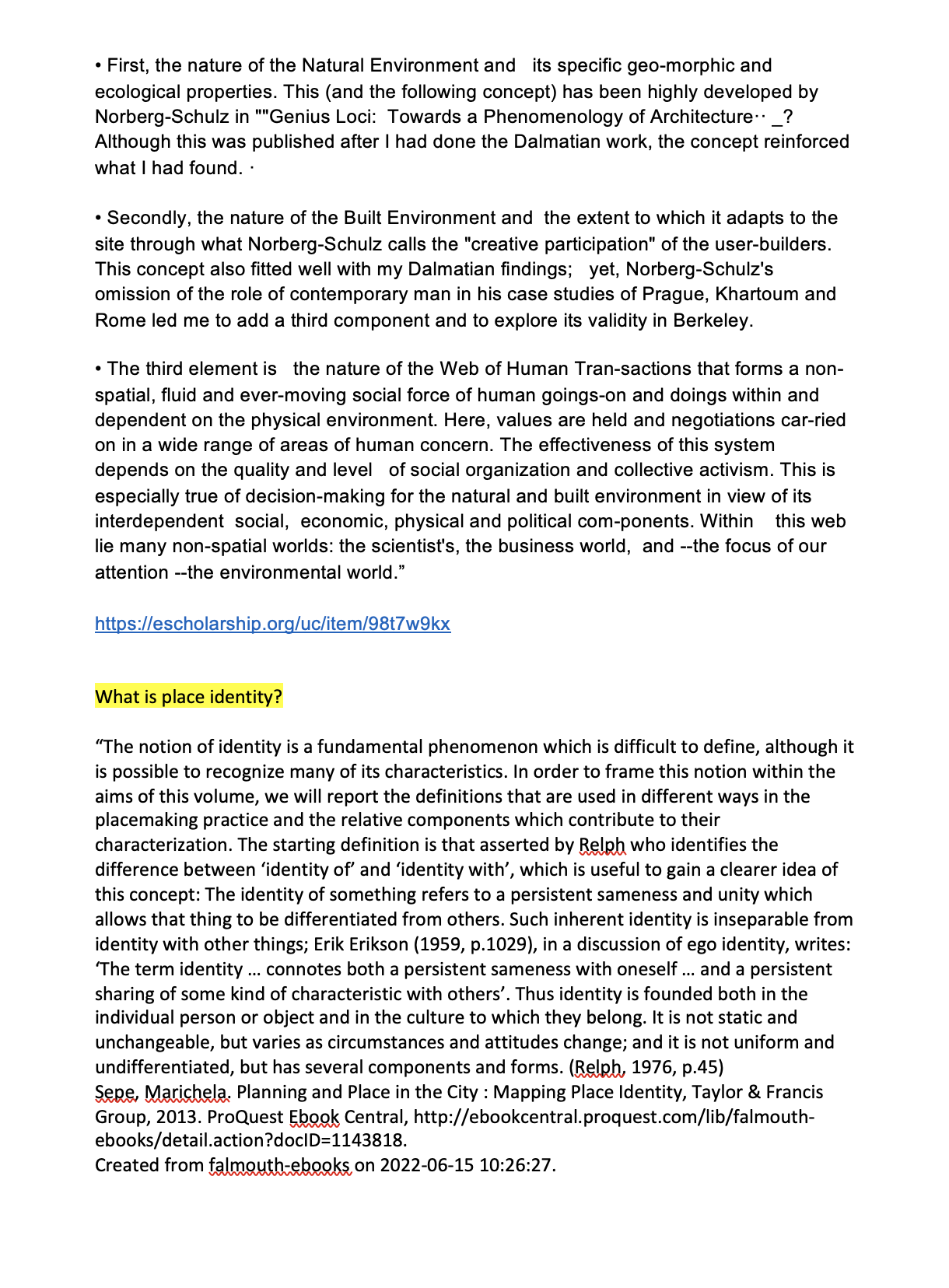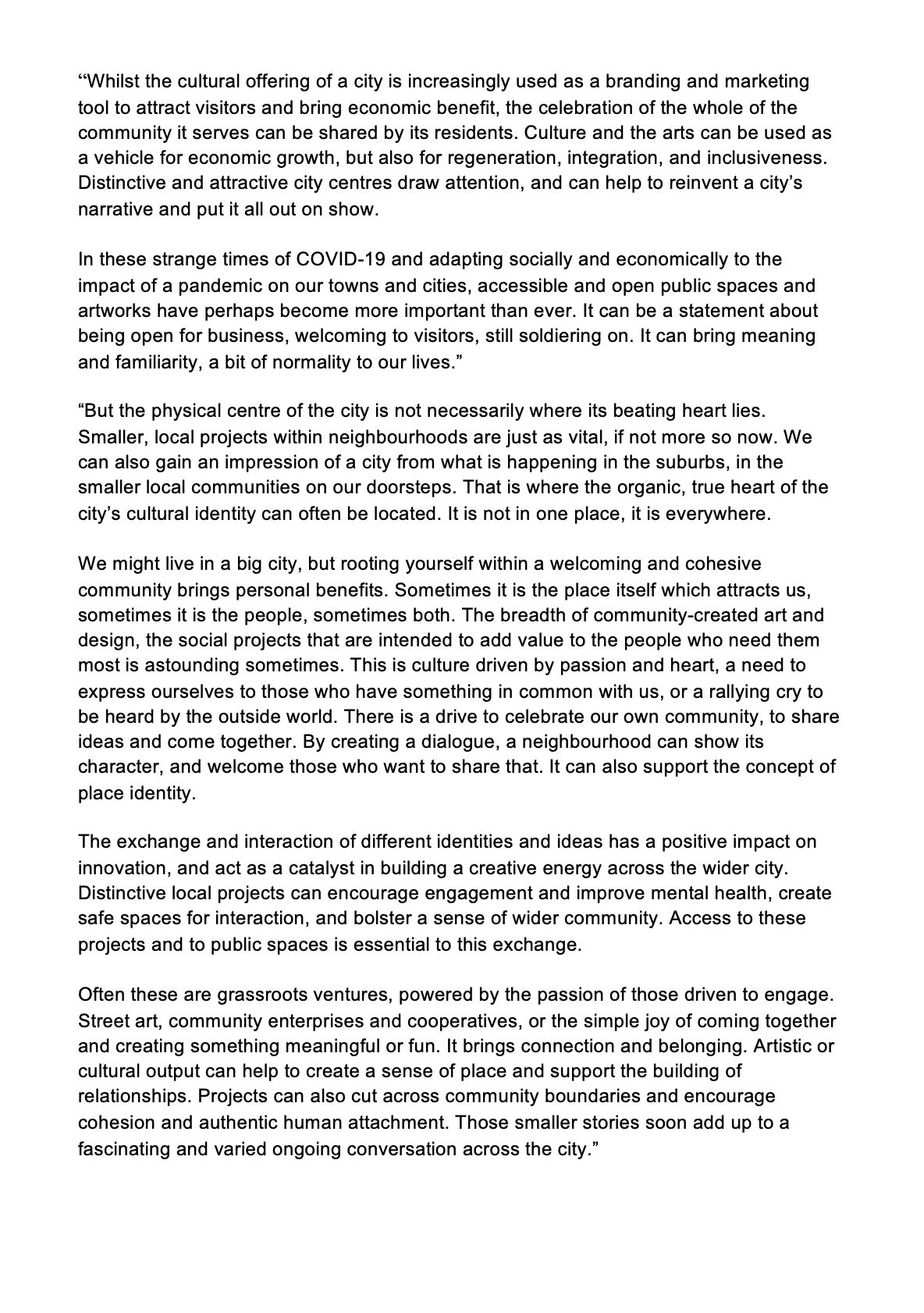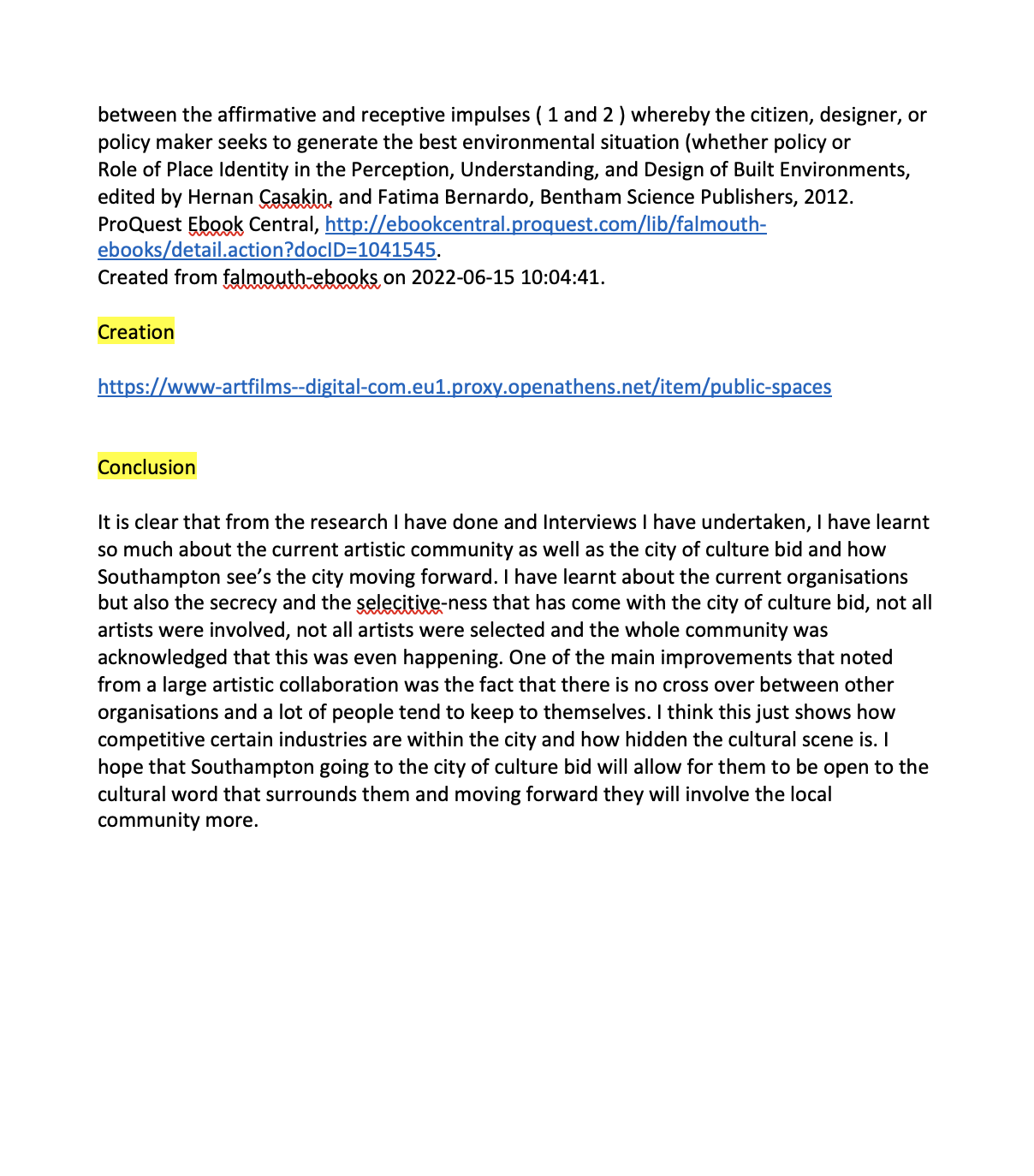Phase 3 - Week Twelve
Focus for the week:
My focus for this week was to have a tutorial with dan and to start some of the interviews and ideation process.
Tutorial with Dan
I decided to book a tutorial with Dan as I was feeling a bit stuck with my draft essay but also wasn’t getting any responses from my emails for Interviews. I was also starting to stress about the design of my final outcome.
Next steps from tutorial:
Keeping with what dan said in mind, I decided to continue with the process of waiting for replies to the emails I sent out and focus on the ones that I had already had responses too. I also decided to write down all the questions that were buzzing around my brain and this would give me a visual que to what I was doing in terms of the project and moving forward. This mind map can be seen below:
I also decided to continue with a research based report for the moment and then if needed I could change this to a business based project.
Interview with Mia & James - ‘a’space
This week, I had a response from the A space people who ended up being Mia and James. We had a great discussion and she even suggested some people to contact which included zest collective, Sarah Filmer as well as somethings I should look up - Exhibition Telephone boxes and Solent showcase. The key points from the interview can be seen below: Due to the nature of the interviews and their profession I decided to not post any of the recorded interviews online.
Within the interview Mia says the following;
“A space was set up for opportunities for artists and created an organisations and create a city where artists might want to stay.”
“One of the main ways we support artists is by providing space, we have arches studios which allows spaces for artists and organisation spaces”
“Ripe is a graduate programme, which are used by graduate artists, an annual programme.”
“Zest collective are graduates from the previous ripe years”
“Graduate retention was the main thing for ripe”
City of Culture
“Yeah, I mean, I think it'll, it'll bring it if nothing else, like a lot of sort of attention, like National kind of media coverage and interests. And I think that's, you know, huge, isn't it? And, yeah, more opportunities for for artists in the city, which is what, we tried to do a space. So yeah, it's, um, it's an exciting prospect. I just hope that, like, if we get it when we get it, but we can like, work in a way that sort of, yeah, that's best for everyone. Like, there's kind of support for grassroots activity as well as sort of top down stuff. Because it does feel a little bit like, I mean, I think it has to work in this way. It does feel like there's a group of people who were like, deciding what city of culture is, and looks like. It doesn't seem to have been huge amounts of like, conversation between those people and the people who live in the city. Yeah,”
“So I was part of a couple of like conversations and focus groups, which were like, I think they would have been, the first ones were quite open. And then the second ones were like, there were these like, five ideas for like themes. And then we discussed each of the ideas. And it was like with other visual art professionals. But even that process, I think some people will put out because the city of culture team had decided who to invite into those rooms. Yeah, like those calls only happened with people who the city team like deemed, like important and to be there. Which, yeah, and itself was a bit problematic, isn't it? Because there must be other people in the city who, like aren't as visible, but his voices would have probably been good to have in the room.”
“98% of the Hull community engaged in the City of Culture in some way”
“A lot of work to be done to make sure that people want to be invited in”
“ I think what would really benefit the city is like more collaboration between the organisations and I think that will then trickle down into the, into the artists and those communities. Yeah, I feel like, it's actually quite an interesting kind of cities comparison, having two years, Plymouth, which is where I grew up. And I feel like in Plymouth, it's very similar city like, it's the same, almost the same population, both houses are like, really bombed during the war, both have got this like, link to like maritime stuff. But I think in Plymouth, they, the visual arts organisations are all a lot more linked up, what you tend to see as you go to an exhibition, and it will be like, sponsored by one of the other galleries or in collaboration with one of the galleries. And I think, you know, when that happens, like the bigger institutions can really benefit from the grassroots stuff, because that's a kind of authentic way into these kind of like the communities that live in that city. And then, you know, the, those kind of grassroots organisations can really benefit from the funding, and the resources and the structure and all of that that's available in the institutions. And I feel like they do that quite successfully implement, but I feel like in Southampton, we don't do it enough. Like, I feel sometimes a space operates as like an island, like, you know, the City Art Gallery and the John Hancock gallery. We don't do any, like cross collaboration, like we don't do any programming with them. We all just have our own separate programmes. Yeah. And that just feels like, yeah, it should change. But I think maybe since you've culture can be can be helpful for that. And one of the ideas that we put a space put in was the visual arts festival, where there's just like, you know, one month of the 2025 year where every single organisation has like something on and you know, so that all the art spaces in the city, and even those that are hidden, or like empty retail units, can all be kind of like opened up. Yeah, I just think some joined up thinking around a festival or something that could happen every other year or every four years or could really help start those conversations’
James:
“definitely it's definitely the case that there's a lot more interesting cultural things going on, then it's perceived. Exactly, yeah. That a reflection of that can only be sort of a positive thing. But I suppose the the issue there is like, you don't want to go so far down that route, that you just discount other aspects? Because if you're talking about Southampton as a city rather than Southampton, cultural identity, you don't want to just be like, yeah, it's corporate city and get rid of like, say the maritime history, which is so important to so many people. And especially as like you were mentioning before, like, the people who've lived here, their whole lifetimes and the older generations who really do know Southampton. Like what what aspect So the city delay taken up for a lot of them it is that maritime history and so many of them are connected. But then there's like other bits, other communities as well. But obviously really influential part of the city as well. Like, what's the what's the Indian festival? Yeah, so like, the Indian community that run like a big, like the biggest festival in Southampton has. So that's like a, obviously a huge part of it. Of the identity of Southampton. as a whole”
The full transcript can be seen here:
https://otter.ai/u/53UIkLGput_1yIgYWacQnxOGAic
The interview with Mia and James was really interesting to hear about A space and what they do as an organisation but to also discuss the future of my project and the city of culture and how it would impact the city and change for the better. I had never thought about how organisations aren’t collaborating but also how this is one of the many organisations to operate across the city. I also felt that the comparison to Plymouth from Mia was a particularly interesting one as there is a lot of similarities within the cities. James also made me rethink how I was going to re brand or re design because it isn’t just for the creative community but the whole community.
Next steps from Interview:
I decided to research the case studies that were mentioned as well as making sure I emailed the people Mia mentioned.
Exhibition - Telephone Boxes:
“K6 Gallery was set up in 2015; it has a permanent exhibition space inside a pair of grade II listed, red telephone boxes in the centre of Southampton. Designed by architect Sir Giles Gilbert Scott in 1935, the K6 was the sixth incarnation of the red phone box; a smaller and more streamlined version of the K2 model.
A small team of volunteers run the gallery, developing and delivering a rich program of exhibitions and events in non-traditional art spaces across the city, engaging audiences by showcasing both local and national artists.”
Zest Collective:
https://www.zestartscollective.com/artists
Interview with Sustainable Collective:
This week I also got in contact with some of my old university friends who have started a collective called the Sustainable Collective. I went to them with the subject and topic of my project and they really helped me to brainstorm and come up with loads of different ways of looking at the project. As you can see from the brainstorm below, we did explore many different areas and random projects and areas but it pushed me to look differently as I felt I was becoming very fixed with the project. Due to the background of their degrees, they also helped me think of ways that the project or the outcome could become or have this sustainable aspect due to Southampton having issues not only with the water levels rising but also having some of the worst air pollution levels which I researched in a previous module.
Below you can see the documents that were created by the sustainable collective in summary of our conversation:
Due to the nature of the interviews and their profession I decided to not post any of the recorded interviews online.
Below you can read the summary that I put together within our collaboration:
The collaboration discussed many ways in which I will be able to produce an end product for the design process but also referred to different case studies that had already been done when looking at my project. They gave me a great refresher on the life cycle of products but also how it can function the environment and how the artists will actually interact with the project and the brief that they would be give. We discussed the weird and wonderful but also discussed things that would directly relate to the city the water front and we tried to take inspiration from the things that Southampton is known for. One of the main realisations was that I just had a concept of the project and I actually hadn’t put together how people would interact but also what the brief would be.
Key quotes from the interview:
“You have to monetize or collaboration be quite cool. Just like, if you invite pen, could you try and get like, nine, per se and nine different designers, artists from different disciplines on the trail, to sort of showcase and then be interactive to sort of like showcase their disciplines, and how they sort of do an on a sort of 10 final grand one, and like, massive collaborative. Final structure piece that just sort of shows all the collaboration between the different disciplines of artists design,
then the the the kind of space itself is then used for collaboration. Is that what you're saying?
We're just, we're just going to share, like, it'd be nice, you're saying in my how well, there's not nice, no uncover expert. It's nice that people want to, and they'd be really nice to show that it's doable. It's in our highlights, the creatives in the city, and that actually is a thing and to sort of make people more aware of it.”
Below is the link to the transcript of the whole conversation;
https://otter.ai/u/ou20aOXobK07DnDGQY2S9TbLoQI
Also the links that were discussed within the discussion:
https://osd.london/project/marble-arch-mound/
https://www.ecologicstudio.com
https://www.greenandblue.co.uk
https://www.weforum.org/agenda/2020/07/tiny-urban-forests-miyawaki-biodiversity-carbon-capture/
https://www.business-live.co.uk/regional-development/plans-mini-eden-project-m5-22805595
https://www.solardome.co.uk/domestic/dome-uses/greenhouse/
https://www.3dnatives.com/en/3d-printed-reef-tiles-120820204/#!
https://www.alex-goad.com/livingseawalls
https://www.bfi.org/about-fuller/geodesic-domes/
https://www.dezeen.com/2019/03/18/lines-pekka-niittyvirta-timo-aha-light-installation/
https://nowthisnews.com/earth/copenhagen-denmark-raising-benches-sea-level-rise
Next steps from interview:
Create an ideation sheet of ideas and research:
Thomas Heatherwick Green Bridge
Within the session there were discussions around Thomas Heatherwick’s Garden Bridge, which was an architectural structure that was placed across the river thames: The following was described by Heatherwick for the ambitious project;
“Following Transport for London’s (TfL) tender for proposals to improve pedestrian links across the river, Heatherwick Studio and actor and campaigner Joanna Lumley have developed an idea for a new pedestrian ‘Garden Bridge’ across the River Thames; a scheme to connect North and South London with a garden. As one of the greenest cities of its size in the world, this precious new piece of landscape will add to London’s rich and diverse horticultural heritage of heathlands, parks, squares, allotments and community gardens and support many indigenous river edge plant species.
The revival of the South Bank over the past two decades has created a vibrant and artistic district attracting large number of visitors to its art galleries, theatres, music halls, restaurants and outdoor entertainment. However, visits to Temple and the north bank area east of Somerset House and Waterloo Bridge are far less frequent. The bridge will grow and nourish the connection between these distinct areas whilst providing new walking routes to and from Covent Garden and Soho.
With a structure that widens and narrows across its span, the elevated garden will not only be a safe and easy way for London’s many commuters and visitors to cross the river, it will also make places along its length for pedestrians to stop and better enjoy the remarkable river setting and unparalleled views of the city. The addition of careful planting with variety in scale, openness and intimacy will create a new kind of public space in the city.”
This project never ended up happening or being constructed but it was interesting to see the vision of creating a new bridge and the impact on the local community in terms of green space.
Marble Arch
From the outside of the Mound it looked like just a structure that was created so that people were able to see some of the iconic London Views. But it’s not till the visitors walk below that there is an light installation by Anthony James. From the website of the mound, it talks about how they are recycling and reusing any of the materials that were used: “Any materials used to build the Mound are being recycled and reused wherever possible to provide a legacy.”
There was also a quote from W1 Curates Director which I thought was really relatable to my own project; “Now more than ever public art projects occupy an important place in the society. They provide opportunity for all to discover and enjoy art, they also encourage much needed footfall back to London. The Marble Arch Mound was a perfect opportunity to collaborate and show London what can be accomplished when we pull together. Art has the power to transform, to illuminate, to educate, inspire and motivate.”
On Design boom they write the following about the project; “yong ju lee designed the project, which was submitted as part of the hangang art competition, using a computer algorithm that generated the bench’s three-dimensional geometry. this mathematical model, known as a reaction-diffusion system, describes the change in space and time of the concentration of one or more chemical substances. thus, the overall radial form was generated with the foreground (installation) merging into its background (grass)”
I really like that people can occupy the bench however they would like to sit on it, run on it and enjoy what has been created for the local community.
Ideation from Sustainable Collective:
From the interview with the sustainable collective, I had realised that I only wanted to source products within a 5 mile radius of Southampton to make sure that the materials were as local as possible. There were also two different approaches within our discussion that really stood out to me:
Tile
I’d never really thought about the shape of the sculptures that I was going to create until today, but I really like the idea of using tiles to create a design, especially after talking to them about making sure they are sustainable. You can see this within the mood-board of the tiles below:
https://www.3dnatives.com/en/3d-printed-reef-tiles-120820204/#!
https://www.alex-goad.com/livingseawalls
https://www.thefutureperfectcompany.com/community-arts-project-with-blind-veterans-uk/
https://www.thefutureperfectcompany.com/community-arts-project-with-blind-veterans-uk/
Glass dome
When thinking of tiles, we discussed how this could be created into domes and within these domes could be glasshouses that also house artists and designers could take over for workshops. You can see the mood-board of the tiles below:
This week I also interviewed Cat’s Boss who was project manager of energise Galasheils. It was really interesting to hear the project from her perspective but also how she managed it,
Below is an extract of the interview: “I was like, right, I'm gonna have to do a really, really good job on this. So what I did was, before we even thought about design, I was like, wait, I need to pull this right back and think about who am I going to get to work on the project. So the first thing that I did was, because part of the scoping that we did, I said, we would not just give the Telenor brand, but we would give a toolkit. And the toolkit is essentially a community asset that will enable any business, any organisation any charity, any skill, any individual to use land, because it has to be seen as a community asset. You need your community to be ambassadors and advocates of this brand, or you're not going to get the traction. So I knew that it had to be more than a logo. So there was photography, videography, copywriting, and actually music, included, in addition to your normal graphic design assets for the brand, because I wanted, no matter what channel they were on, I wanted everything to be really bad to establish your brand. So I looked around for people who could produce all of those assets from but they were either Galashiels people are the lift and gala shields now, because I want every everybody who was involved in it passionately cared about the tone. And I totally get it. That's not always possible. But for me, it was really important. And we made that happen. So the first thing that we did was we started doing PR PR about your project, because it was all about getting the tone excited about the fact that it was going to have a brand. And we had a view. Are you aware of the film The Usual Suspects? No. Okay, you're far too young. That's really good. It's really it's really like iconic film. And there's a full always like the lineup of the usual suspects. So we did this whole the usual suspects or unusual suspects. I think we did. And all of the creatives, we were all lined up against this wall. And we were like, Yeah, we're then usual suspects that are going to be rebranding gala shields, and we you know, we got a lot of really good traction. And straight away what it meant was, we could mitigate as much as possible any negativity around the brand, because what we were seeing right from the start was this brand has been created for Galashiels by people who cared about Galashiels. You know, it's not If it'd been a Birmingham firm, the first thing that people would have said was, Oh, my goodness, you're investing in the town but you're sending money away, don't Birmingham to you know, probably a massively expensive design agency. People who don't even know where Galashiels is on the map, I mean, that that would have been a negative but we sort of saw reportedly mitigated that. So we work we were working on that and then the next thing I did was and this is really important, hilt together a stakeholder group of key people in the town and what essential is essential without was I had the formal influence are so your counsellors your you know, the skills the business people? That was always people aren't like, that just seem to have a really strong voice in the time so for me, there's just one old human called Beatty Scott, right? She's like 86 or something, but she she rules the roost in the tone.”
From the interview with Emily, I learnt that it was crucial that I needed to talk to people within the community for my project as I feel these are the people that will know the project the best and be able to give me the best insight. I also think that taking inspiration from the local town like Cat did to create the design is also a key part of the process. Another key part is testing the idea to the community and asking their thoughts on it, this is where honesty is the best policy for the design. Emily also mentioned that the process will take a long time and they are still rolling out the identity for the town and getting the local community used to the idea.
The transcript of the interview can be read here:
From this interview I decided that I need to make a questionnaire that I would need send out the local community to get their opinion on multiple things.
Change of Direction
From this week, I feel I was able to push my project in a different direction by clarifying some of the questions that I asked myself in response to dan’s tutorial. I also felt that the sustainable collective were able to help me push my design ideas in a different direction and to think more about the concept and how it would work and what the process would be.
Who is this for?
This project is for the creatives of the city to allow them to be put to the forefront but to also show the cultural identity does exists within the city.
Business or not?
Not business plan
What is the final result?
The final result will be an installation across the city close to historic landmark locations
What do i want to know from the interviews?
I want to understand the current organisations, artists and designers - what they think about Southampton? what their thought on collaboration is and about the city of culture to understand what needs improving when we get the money?
How would i use their responses?
I will use their responses within my research and to gain a wider understanding of the project and the community as they are my target audience.
Why am i doing this?
I am doing this to bring the creatives to the forefront of the city that will allow them to connect with other artists and designers. It will also show the local community what is available culturally for the city
How can I evolve the project?
I can evolve this project by continuing to do research and understand about the topic but to not get to carried away with the broad of the research area.
What is cultural identity?
“Cultural heritage is a group of lifestyles which transmit from one generation to other including the manifestations of tangible and intangible heritage. So, the preservation of the cultural identity factor will be automatically contributed to preserving the outstanding universal values of the heritage cities including its authentic value. For instance, Paris is distinguished being a romantic city; Berlin is a capital of architecture; Salvador de Bahia is capital of happiness, and so on. The local community is a fundamental tool of managing globally the urban heritage, strengthening their cultural identity and the sense of belonging, in coordination with the urban governance, the investors and the local users who contribute adaptively reusing the historic public spaces.”
https://www.researchgate.net/publication/333798394_Cultural_Identity_Curating_the_Heritage_City
“Culture is the shared characteristics of a group of people, which encompasses , place of birth, religion, language, cuisine, social behaviors, art, literature, and music. Some cultures are widespread, and have a large number of people who associate themselves with those particular values, beliefs, and origins. Others are relatively small, with only a small number of people who associate themselves with that culture. However, the value of culture cannot be defined by its size. No matter if a culture is widespread or kept within a small region, is young or old, or has changed over time or stayed the same, every culture can teach us about ourselves, others, and the global community. Learn about the concept of culture while empowering students to learn about themselves and others with this curated collection of resources.”
https://education.nationalgeographic.org/resource/resource-library-cultural-identity
Why is having a cultural identity important?
“Whilst the cultural offering of a city is increasingly used as a branding and marketing tool to attract visitors and bring economic benefit, the celebration of the whole of the community it serves can be shared by its residents. Culture and the arts can be used as a vehicle for economic growth, but also for regeneration, integration, and inclusiveness. Distinctive and attractive city centres draw attention, and can help to reinvent a city’s narrative and put it all out on show.
In these strange times of COVID-19 and adapting socially and economically to the impact of a pandemic on our towns and cities, accessible and open public spaces and artworks have perhaps become more important than ever. It can be a statement about being open for business, welcoming to visitors, still soldiering on. It can bring meaning and familiarity, a bit of normality to our lives.”
“But the physical centre of the city is not necessarily where its beating heart lies. Smaller, local projects within neighbourhoods are just as vital, if not more so now. We can also gain an impression of a city from what is happening in the suburbs, in the smaller local communities on our doorsteps. That is where the organic, true heart of the city’s cultural identity can often be located. It is not in one place, it is everywhere.
We might live in a big city, but rooting yourself within a welcoming and cohesive community brings personal benefits. Sometimes it is the place itself which attracts us, sometimes it is the people, sometimes both. The breadth of community-created art and design, the social projects that are intended to add value to the people who need them most is astounding sometimes. This is culture driven by passion and heart, a need to express ourselves to those who have something in common with us, or a rallying cry to be heard by the outside world. There is a drive to celebrate our own community, to share ideas and come together. By creating a dialogue, a neighbourhood can show its character, and welcome those who want to share that. It can also support the concept of place identity.
The exchange and interaction of different identities and ideas has a positive impact on innovation, and act as a catalyst in building a creative energy across the wider city. Distinctive local projects can encourage engagement and improve mental health, create safe spaces for interaction, and bolster a sense of wider community. Access to these projects and to public spaces is essential to this exchange.
Often these are grassroots ventures, powered by the passion of those driven to engage. Street art, community enterprises and cooperatives, or the simple joy of coming together and creating something meaningful or fun. It brings connection and belonging. Artistic or cultural output can help to create a sense of place and support the building of relationships. Projects can also cut across community boundaries and encourage cohesion and authentic human attachment. Those smaller stories soon add up to a fascinating and varied ongoing conversation across the city.”
Weekly Summary
This week has allowed me to reflect on my project so far and to continue researching and learning about what it means to design an identity as well as a project for the community. Although I haven’t focussed on the design work so much so far, I feel these weeks were crucial in creating a foundation for the project and to really understand why I am doing it and what I am doing for the creative community. I am slightly scared at this point that it seems like a huge project that I may not have time to do everything in regards to also creating this identity along side the collaboration process project. But I will continue to see where the research takes me.
Resources
Amer, M. (2018). Cultural Identity: Curating the Heritage City. Research gate.
designboom | architecture & design magazine. (2018). ‘root bench’ is a giant circle-shaped structure designed by yong ju lee. [online] Available at: https://www.designboom.com/architecture/yong-ju-lee-root-bench-seoul-11-21-2018/
education.nationalgeographic.org. (n.d.). Cultural Identity | National Geographic Society. [online] Available at: https://education.nationalgeographic.org/resource/resource-library-cultural-identity.
Heatherwick Studio | Design & Architecture. (n.d.). Heatherwick Studio | Design & Architecture | Garden Bridge. [online] Available at: https://www.heatherwick.com/project/garden-bridge/
k6gallery.com. (2022). K6 Gallery in Southampton» About. [online] Available at: https://k6gallery.com/about
osd.london. (2021). THE MARBLE ARCH MOUND – OXFORD STREET DISTRICT. [online] Available at: https://osd.london/project/marble-arch-mound/.
The State Of The Arts. (2018). Consuming Culture: The heart of the city’s cultural identity is not in one place, it’s everywhere. [online] Available at: https://www.thestateofthearts.co.uk/features/consuming-culture-the-heart-of-the-citys-cultural-identity-is-not-in-one-place-it-is-everywhere/.
www.westminster.gov.uk. (2021). W1 Curates and Anthony James’ exhibition launches at Marble Arch Mound | Westminster City Council. [online] Available at: https://www.westminster.gov.uk/news/w1-curates-and-anthony-james-exhibition-launches-marble-arch-mound
ZEST Collective. (n.d.). ARTISTS. [online] Available at: https://www.zestartscollective.com/artists
Draft of Critical Report
My draft of my critical report ended up being all of my research collated together which can be seen below. I will continue to update and write the critical report over the upcoming weeks:



